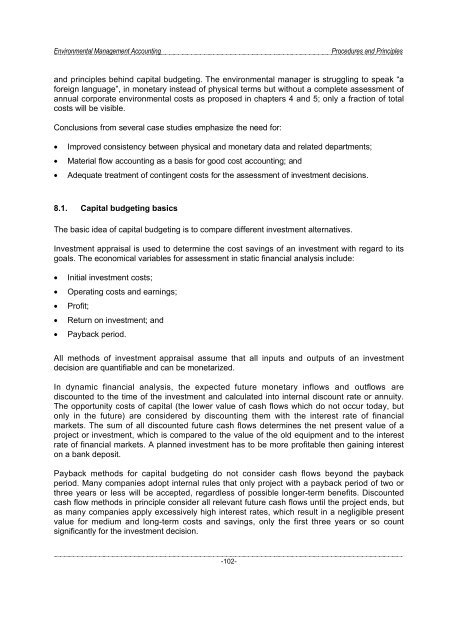Environmental Management Accounting Procedures and Principles
Environmental Management Accounting Procedures and Principles
Environmental Management Accounting Procedures and Principles
Create successful ePaper yourself
Turn your PDF publications into a flip-book with our unique Google optimized e-Paper software.
<strong>Environmental</strong> <strong>Management</strong> <strong>Accounting</strong><br />
<strong>Procedures</strong> <strong>and</strong> <strong>Principles</strong><br />
<strong>and</strong> principles behind capital budgeting. The environmental manager is struggling to speak “a<br />
foreign language”, in monetary instead of physical terms but without a complete assessment of<br />
annual corporate environmental costs as proposed in chapters 4 <strong>and</strong> 5; only a fraction of total<br />
costs will be visible.<br />
Conc lusi ons f r om several c as e s tudi es emphasi ze the need f or :<br />
• I mproved c onsi st enc y bet ween phys i cal <strong>and</strong> monetary dat a <strong>and</strong> r el ated depar tment s;<br />
• Materi al fl ow ac count ing as a bas is f or good cost ac count ing; <strong>and</strong><br />
• Adequate tr eat ment of c ont ingent cost s for t he as ses sment of inv es tment dec i si ons .<br />
8.1. Capital budgeting basics<br />
The basic idea of capital budgeting is to compare different investment alternatives.<br />
Investment appraisal is used to determine the cost savings of an investment with regard to its<br />
goals. The economical variables for assessment in static financial analysis include:<br />
• Initial investment costs;<br />
• Operating costs <strong>and</strong> earnings;<br />
• Profit;<br />
• Return on investment; <strong>and</strong><br />
• Payback period.<br />
All methods of investment appraisal assume that all inputs <strong>and</strong> outputs of an investment<br />
decision are quantifiable <strong>and</strong> can be monetarized.<br />
In dynamic financial analysis, the expected future monetary inflows <strong>and</strong> outflows are<br />
discounted to the time of the investment <strong>and</strong> calculated into internal discount rate or annuity.<br />
The opportunity costs of capital (the lower value of cash flows which do not occur today, but<br />
only in the future) are considered by discounting them with the interest rate of financial<br />
markets. The sum of all discounted future cash flows determines the net present value of a<br />
project or investment, which is compared to the value of the old equipment <strong>and</strong> to the interest<br />
rate of financial markets. A planned investment has to be more profitable then gaining interest<br />
on a bank deposit.<br />
Payback methods for capital budgeting do not consider cash flows beyond the payback<br />
period. Many companies adopt internal rules that only project with a payback period of two or<br />
three years or less will be accepted, regardless of possible longer-term benefits. Discounted<br />
cash flow methods in principle consider all relevant future cash flows until the project ends, but<br />
as many companies apply excessively high interest rates, which result in a negligible present<br />
value for medium <strong>and</strong> long-term costs <strong>and</strong> savings, only the first three years or so count<br />
significantly for the investment decision.<br />
-102-




